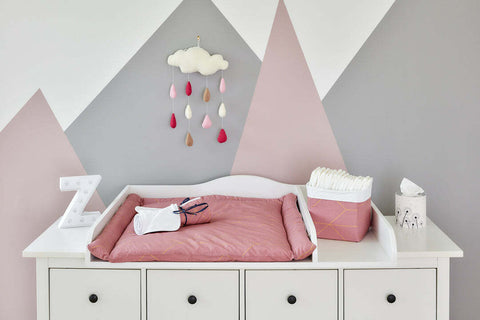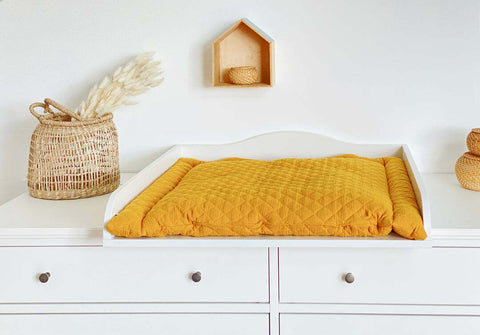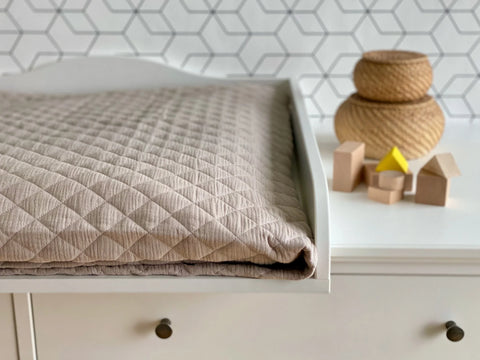
Choosing the right changing mat can be a challenge for new parents. With so many options on the market, it is important to make an informed decision. This article aims to help you do exactly that. With a focus on quality, comfort and design, we walk you through the essential factors to consider when choosing the best changing mat.
1. The importance of making the right choice
First of all, good changing mats must protect babies' delicate skin. They should be made of soft but durable materials that provide a comfortable surface to lie on without babies lying directly on cold and hard surfaces. This is especially important since newborns and young babies spend a large part of their day being changed and cared for.
Another important consideration is hygiene. The changing mat must be easy to clean to ensure a healthy environment for the baby. Accidents while diapering are normal, so having a surface that can be cleaned quickly and efficiently is crucial to keeping germs and bacteria away.
The protections are another crucial aspect. Optimal changing mats not only offer soft padding, but also protective features such as raised edges that prevent babies from rolling off. These features help limit babies' movement on the pads, providing additional protection during changing.
Adaptability also plays a role. The best changing mats not only fit most changing tables and tables, but are also easy to transport and use as needed in different places around the house or on the go. This flexibility is particularly important for families who lead an active lifestyle and need a solution that can adapt to different situations.
Finally, long-term uses are factors that should not be overlooked. High-quality changing mats not only withstand the rigors of everyday use, but can also be reused for future siblings. Investing in long-lasting, versatile and safety-tested changing mats is a decision that will pay off in the long term.
Making the right choice in changing mat means considering all of these factors to ensure a safe, comfortable and practical solution for caring for your baby. Making a thoughtful decision at this time will not only support your baby's development and well-being, but will also make caregiving tasks easier for parents.
2. Materials and processing
The selection of material and the quality of workmanship are crucial factors that determine the longevity, functionality and protection of a changing mat. When comparing different materials, parents should consider their properties in terms of comfort, ease of care and environmental impact.
- Cotton is a popular material for changing mats because it is natural, soft and breathable. Cotton pads provide a gentle surface for baby's sensitive skin and reduce the risk of skin irritation. They are also usually easy to wash and dry. However, cotton pads without a waterproof layer can quickly absorb moisture, requiring more frequent washing.
- Polyester is a synthetic alternative known for its durability and easy cleaning. Polyester changing mats are often water-resistant, making them a practical choice for quick and easy cleanups. They dry quickly and retain their shape even after repeated washing. However, they can be less breathable than cotton, which can be a concern for sensitive baby skin.
- Plastic-based changing mats offer the advantage of being extremely easy to clean and waterproof. They are ideal for parents who value hygiene and easy maintenance. These pads can be easily wiped clean with a damp cloth, eliminating the need for frequent washing. However, the plastic surface can be less comfortable for the baby and feels colder than fabric pads. Nevertheless, plastic changing mats are a practical alternative for certain applications.
3. Safety and comfort
Protection and comfort are two of the essential criteria when choosing the ideal changing mat for your baby. These two elements play a central role in your child's well-being during the changing process and help ensure a relaxed atmosphere for parents and child.
Security aspects
- Raised edges: High-quality changing mats have slightly raised edges, which are an additional safety feature. They help minimize the risk of the baby rolling off the pad. However, these edges should not be so high that they make handling difficult when changing diapers.
- Non-slip base: A non-slip base is used to ensure that the changing mat is positioned stably on the changing table or other surface. This prevents the pad from slipping during use and provides additional protection.
- Free from harmful substances: Materials that come into direct contact with the baby's sensitive skin should be free from harmful chemicals and pollutants. Look for certifications like Oeko-Tex that guarantee the products are safe for your baby.
Comfort feature
- Soft surface: The surface of the changing mat should be soft and comfortable for the baby's sensitive skin. Materials such as cotton or soft polyester fleece offer a high level of comfort and prevent skin irritation.
- Appropriate padding: Good padding is important to provide a comfortable base for the baby. It should be firm enough to provide support without being too hard. The right balance of softness and support contributes to baby's comfort.
- Heat regulation: Materials that offer good heat regulation are preferable. They keep the baby warm without causing overheating. Breathable materials such as cotton help regulate baby's body temperature naturally.
Protection and well-being go hand in hand when it comes to choosing the right changing mat. By considering these aspects, parents can create an environment that is not only protected but also welcoming and comfortable for their baby.

4. Design and style
While protection and comfort are essential when choosing a changing mat, design and style also play a significant role. A changing mat not only has to be functional, but can also be an aesthetic element in the children's room. The right choice can enliven the room and create a comfortable atmosphere for you and your baby.
Influence of design on the environment
- Colors and Patterns: Changing mats are available in a variety of colors and patterns. Bright and cheerful colors can create a stimulating environment for baby, while softer tones can be calming and help relax. Patterns, from classic stripes to modern graphic designs, offer the opportunity to express personal preferences and complement the design of the child's room.
Style and individuality
- Unique Designs: Brands like KraftKids stand out by offering unique changing mat designs. With a wide range of patterns designed specifically for the brand, parents can choose a changing mat that is not only functional but also uniquely stylish. Visit KraftKids to find a changing mat that perfectly suits you and your baby's style.
Material and texture
- Texture as a style element: In addition to color and pattern, the texture of a material can also contribute to the style of the changing mat. Soft, plush materials not only feel comfortable, but can also be visually appealing. Smoother materials like plastic can provide a more modern look while also being convenient for cleaning.
The design and style of a changing mat is therefore not just a question of personal preference, but also an opportunity to consciously design the child's environment. By choosing a changing mat that combines protection and comfort with aesthetic appeal, you create a welcoming and stylish space that promotes your baby's well-being and development.
5. Practical aspects
When choosing a changing mat, in addition to protection, comfort and design, practical aspects should also be taken into account. These factors help to simplify everyday life for parents and ensure a hygienic, comfortable changing environment for the baby. In addition, the quality and durability of the changing mats also play a crucial role. A well-equipped changing table can also help make the changing ritual more pleasant and efficient.
6. Choose the right size
The size of the changing mat is an essential aspect that is often overlooked, but is crucial for protection, comfort and practical use in everyday life. An appropriately chosen size ensures that the changing mat not only fits on the changing table or changing table, but also offers enough space for the baby to feel comfortable while changing without compromising protection. A well-chosen changing table can help keep changing supplies organized and within easy reach. In addition, a changing attachment on the dresser can be a practical addition to optimize the use of the changing area.

7. Accessories for changing mats
The right accessories for changing mats can not only make the changing process easier, but also increase the protection and comfort of the baby. From changeable covers to additional protective straps - there are a variety of accessories that enhance the functionality of the Improve changing mat. In addition, waterproof changing mats can also be a useful addition to provide additional protection against dirt. A high-quality changing mat cover also helps improve hygiene and makes cleaning the changing mat easier.
8. Durability and quality
Investing in a changing mat of high quality and durability is not only a matter of cost-effectiveness, but also comfort and protection for your baby. High-quality changing mats provide reliable performance over time and help create a protected and comfortable changing environment. In addition, additional changing mats can be a practical addition to make cleaning and protecting the changing table easier. A suitable changing trough can help make the changing area even more comfortable and safe. Choosing the right size changing mat is crucial to ensure it fits perfectly on your changing table and provides optimal comfort.
9. Value for money
Value for money is a crucial factor when buying a changing mat. It's not just about finding the cheapest product, but choosing a changing mat that is both high quality and economical. A good changing mat should strike a balance between cost, durability, protection and the practical needs of everyday life. Changing mats can be a useful addition to ensure additional protection and hygiene. When choosing the right size changing mat, it is important to consider individual requirements and the space available.
FAQ – Frequently Asked Questions
Which changing mat for newborns?
For newborns, we recommend changing mats that are particularly soft and supportive, providing a safe and comfortable surface. It is important that the mat has raised edges to prevent the baby from rolling off. Materials such as cotton or a soft polyester fleece are ideal as they are gentle on the newborn's sensitive skin. Also make sure that the changing mat is free of harmful chemicals and offers a good fit for your changing area.
What is important in a changing mat?
The most important factors in a changing mat are material, safety features, size, ease of care and design. A quality changing mat should be made from soft, durable materials, be easy to clean and have safety features such as raised edges. It should fit well into the chosen changing area and of course also be visually appealing in order to fit into the overall look of the child's room.
Which changing mat is practical?
A practical changing mat is characterized by its ease of care and durability. Models with water-repellent surfaces or removable, machine-washable covers are particularly practical as they are easy to keep clean. Plus, changing mats that are portable and easy to store are ideal for on-the-go parents. A non-slip base also ensures additional security when changing diapers.
Which is better: wide or narrow changing mat?
Choosing between a wide or narrow changing mat depends on the space available on your changing table or changing table as well as personal preference. Wider mats provide more space for the baby and additional room for changing supplies, but can be used on smaller changing tables be too big. Narrow changing mats fit better in tighter spaces, but may not provide as much freedom of movement for the baby. Measure your changing area to determine the best size for your needs.



